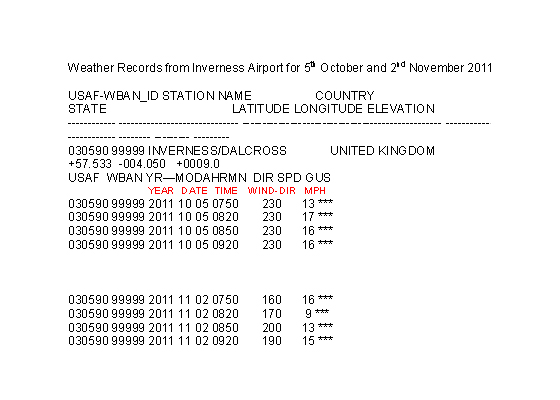
An examination of the claims and pictures taken by George Edwards
A Summary can be found at the bottom of the page. Reload the page at each visit to receive any updates.
1. Edwards Deep
2. The 1986 Photograph
3. June 2012 Verbal Testimony
4. The November 2011 Photograph
1. Edwards Deep
The story of Edwards Deep - I suggested the name - originates with the skipper of a local tour boat George Edwards, who picked up depth readings of 247 metres, or 812 feet on the fishfinder sonar on his cruise boat "Nessie Hunter". The story is told in his own words on the "Legend of Nessie" website, and a brief, edited version is given as Item 1 below. The significant information is that the location is in the vicinity of Urquhart Castle.
I worked as relief skipper on the "Nessie Hunter" for ten years and agree that the boat's sonar does produce these signals from time to time, but they are not a true indication of depth...it would be hard to explain how a 60 foot deep crater in the otherwise incredibly flat bottom sediment did not fill up. The equipment is showing a sidewall echo.
What is a side-wall echo?
In simple terms, it is an echo picked up from the side
of the loch when the side is still further away than the bottom directly
below the boat.
I have recorded similar traces on other boat sonars and show here a similar but deeper echo, also recorded in the vicinity of Urquhart Castle.
Copyright Dick Raynor 2009 Right-click on the image, then select "play"
The newest Admiralty Chart of the area is based on data gathered during a joint Loch Ness Project / BBC Science Unit survey in 2002. The maximum depth recorded in the survey was 227 metres, despite special attention being paid to the area of "Edwards Deep". This depth is less than 3 metres different from that recorded by Murray and Pullar in 1903.
If the Loch Ness Project / BBC data is good enough for Her Majesty's Hydrographer it is good enough for me, and I can be confident that Edwards Deep does not exist. On a tourist trip in June 2012 George Edwards told passengers the story of Edwards Deep but also said it was "further down the loch" and no attempt was made to demonstrate it on any of the on-board sonars.
2. The 1986 Photograph - "The Loch Ness monster?"
Passengers on George Edwards Cruise boat "Nessie Hunter" between 1996 and 2011 will also be familiar with the photograph he took in 1986, for sale on the boat as a postcard for 50 pence. I remember him telling me at the time how hard it had been to drag the offending object out of the back of a vehicle and down to the water before it was towed out into the loch! The story changed, and George Edwards' newer version can be watched below.
Right-click on the image, then select "play"
By the time of that interview he had seen "these creatures 16 or 17 times".
3. A June 2012 Boat Trip on Nessie Hunter IV
A passenger on a boat trip in June 2012 made a recording of George Edwards discussing his sightings and the poster which I use here as a background image. The soundtrack has a high level of engine noise inside the cabin but records some important comments.
Right-click on the image, then select "play"
4. The "November 2nd 2011" Photograph, "Released" August 2012
At the beginning of August another photograph was released to the worlds media in a flurry of publicity, said to have been taken at 9 a.m. on 2nd November 2011, but not released until August 2012.
From the Daily Mail (see link at end of quote) " I
hung around for a good half-an-hour and used the deep scanning sonar to try and
pick it up, but I’m afraid I had no luck at all.'
Mr Edwards took the photo at 9am on 2nd November last year on a compact Samsung
digital camera that he always keeps on the boat.
Before releasing it publicly he sent it to the USA for analysis, though he can’t
reveal further details.
'I did not want to mention my sighting until I was sure that I had not
photographed a log or something inanimate in the water,' he said. 'I have
friends in the USA who have friends in the military.
'They had my photo analysed and they have no doubt that I photographed an
animate object in the water. I was really excited as I am sure that some strange
creatures are lurking in the depths of Loch Ness.'
Read more:
http://www.dailymail.co.uk/news/article-2183094/Skipper-claims-finally-proof-Loch-Ness-Monster-exists.html#ixzz23R9PIXSd
So the photos "released" at the beginning of August 2012 were already displayed and on sale in postcard form on the boat at the time of the June 2012 boat trip.
Obviously a mistake somewhere. Now let us look again at the poster Mr Edwards is talking about in the audio file. Photo 3, the "new" picture, has a caption "Taken by George Edwards on 5/10/11" ... but it was really taken on 2nd November 2011, wasn't it? A bit of a mix up. A lovely clear calm day, however...

(Data supplied by NNDC Climate Data at http://.hurricane.ncdc.noaa.gov)
the weather on both days claimed for the photography is different from that shown in the picture. Furthermore, the Great Glen acts as a funnel for the wind and surface wind speeds are often 50% to 100% greater that those measured at Inverness airport. Even without this effect, the waves in the photo are not those produced by a 13 or 16 mph wind.
In the words of the BBC Weather Centre, these two days were described as follows:
BBC Weather Report for 5/10/2011:
Review of UK weather on 05/10/11
Much of the UK was cloudy overnight through to the early hours but there were a few clear spells in the southeast of England.
There were outbreaks of drizzle in some western parts of England and Wales.
Further north, outbreaks of rain pushed east across Scotland, Northern Ireland and northern England and rain was heavy across western hills in Scotland.
During the morning some sunshine broke through across sheltered parts of eastern England but it was generally cloudy and wet further north and west.
Rain across the north gradually slipped southeastwards during the afternoon, turning heavy across Cumbria and then Wales.
Southern and southeast England hung onto some drier weather but rain reached here in the evening, this heavy at first.
Behind the band of rain, scattered sharp showers developed with sunny spells.
Winds were strong for many throughout the day, reaching gale force over many hills and exposed peninsulas from north Wales northwards. Gusts at low levels reached 61 mph at Aberdaron in the late afternoon.
Temperatures were generally above average, becoming warm in the southeast ahead of the rain.
http://news.bbc.co.uk/weather/hi/uk_reviews/newsid_9608000/9608839.stm
So the weather on 5th October 2011 is not as shown in the photograph. Let's try 2nd November 2011.
|
Review of UK weather on 02/11/11 |
|
Parts of northeast England saw some fog and a local ground frost at first on Wednesday morning. However this soon cleared to leave a good part of England, Wales and Scotland dry with some bright or sunny periods. Northern Ireland and the far west of Scotland were cloudier with outbreaks of rain to start the day. As the day progressed, this cloud and rain continued to spread eastwards and by lunchtime much of the western half of the UK was cloudy. Through the afternoon, outbreaks of rain spread into southwest England and Wales, with some of this turning out to be quite heavy. By the evening, the rain had worked its way into central southern England, the Midlands and southwest Scotland. Areas across eastern England and Scotland that had seen some afternoon sunshine also turned cloudier. Across the country it was a windy day, with the southeasterly winds at their strongest in exposed parts of the west. It was a mild day, with temperatures generally above average for the time of year again. |
|
http://news.bbc.co.uk/weather/hi/uk_reviews/newsid_9630000/9630701.stm
Not a good match either - "across the country it was a windy day".
A useful feature of the Internet is that one can find various versions of a story, or a photograph. The "November 2nd 2011" photograph on the website of the agency that handles George Edwards' photo - http://www.cascadenews.co.uk/site/node/33 - has the least cropped version of it on the website linked above. The picture is below.

Look carefully at the bottom left hand corner to see something white at the edge of the frame.
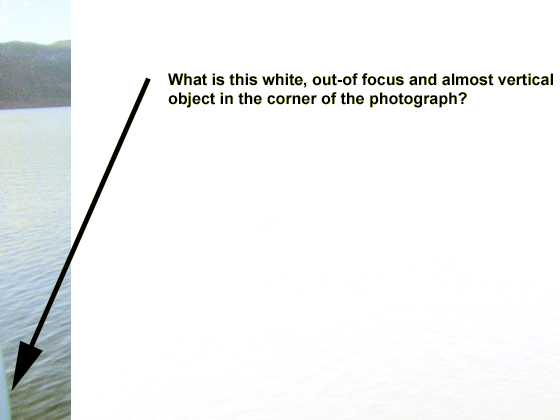
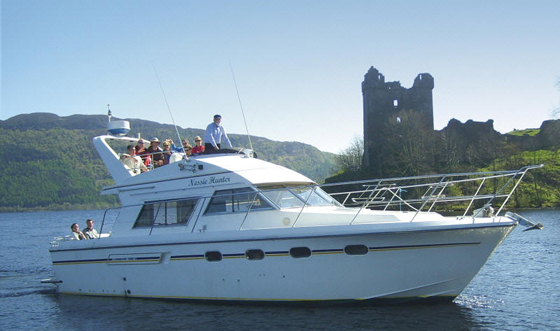
What on Nessie Hunter IV (above) could that white part of the boat possibly be?
There is no part of that boat which would correspond with the object in the photograph.
Let's try a different boat.
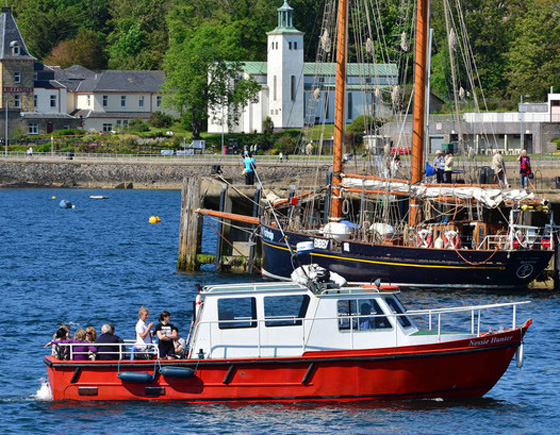
© Copyright TheTurfBurner , from Geograph.org NM8529.
and a zoom in...
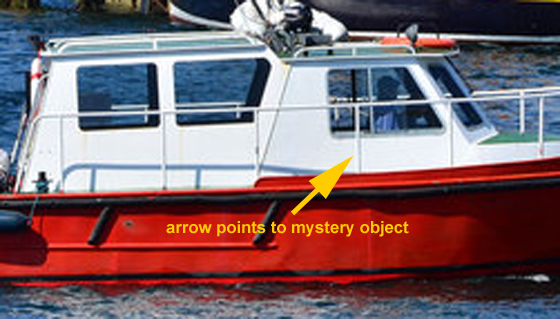
White stanchions support handrail
Nessie Hunter III, George Edwards' previous boat has exactly what we are looking for, shown here in Oban where it was working in 2011. So it would appear that the photo most likely was not taken on either of the dates stated due to the weather, or even in the year stated due to the wrong boat being partially included in the picture.
Keen observers have commented that although Mr Edwards is quoted as saying the object was about half a mile away from him in the "November 2011" photo, it looks much closer than that. In the sountrack above, Mr Edwards says " ... and you can see the castle in the top right hand corner of the photograph so you will be able to work out for yourselves that I was much farther down the loch near Lochend when I took that picture."
I would respectfully disagree.
The top of the castle tower - height 25 m above water level - aligns well with the summit of Carn Dearg 277 m above loch level in the background, beyond Foyers. We can project a line from the hilltop, through the castle tower and down into the loch.
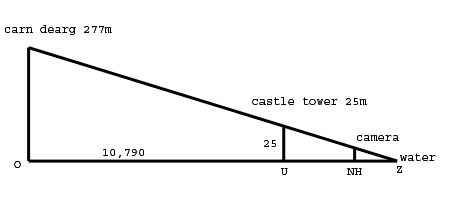
The distance between the hilltop and the castle is known to be 10,790 metres so it is a simple matter of solving similar triangles the get the range to the water surface, which comes out at 11,860m. So the sight-line from the hill-top enters the water 1070 metres past the castle, and the angle at the hilltop = inverse tan (11860/ 277) is 88.66 degrees.
If the camera was shooting under the handrail from the skipper's window we can estimate a camera height above the water of 2.0 metres, so the distance NH to Z divided by 2.0 metres = 11860/277so the sight line enters the water 86 metres past the camera, so the camera was 1070 - 86 = 984 m from the tower.
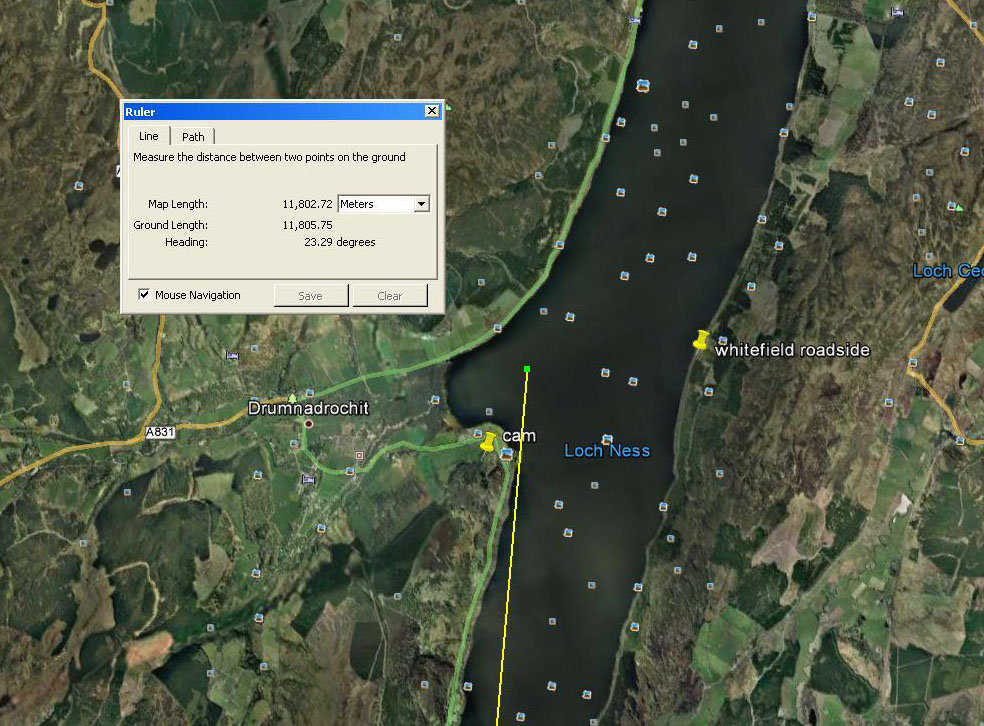
Calculated boat position is near the green square at the end of the yellow line, in the middle of Urquhart Bay.
Knowing the distance of the camera from the castle with reasonable accuracy, and knowing its height, we can scale the photograph and the tower is calculated to be 1.45 degrees in height. By measurement from the photo the object of interest can be seen to be 8 times the castle height below the horizon and so some 9.5 metres horizontally from the camera. It appears to be about 0.60 metres or 24 inches long. Further discussion of the nature of the object is unnecessary .
All of this should not come as a surprise, of course as George Edwards did say at the end of the soundtrack that the last time he saw one of the creatures was on 13th May 2003 - over 9 years earlier.
Item 1 - included to demonstrate stated position of "Edwards Deep"
"This story begins back on 30th November 1989 whilst a friend of mine and
myself were taking part in a coastguard exercise on Loch Ness. … The exercise
involved all the main emergency services and most the other vessels which
operate on Loch Ness, including the cruise boat "Nessie Hunter", of which I am
the skipper. The exercise was due to begin at 12 noon, my remit was to be in the
position, that I would normally be, with Nessie Hunter at that time of day,
which in my case would be in the vicinity of Urquhart Castle. Unfortunately,
things did not go according to plan, a real situation had developed in the North
Sea and I was instructed to maintain a holding pattern in the Urquhart Castle
area, and await further instructions. We had settled down and were having coffee
and sandwiches when I happened to look at the sonar screen, and much to my
surprise, I noticed a depth reading of 787 feet, about 37 feet more than I had
previously recorded in this area! I pointed this out to my friend and
immediately all thoughts of the chocolate biscuits which we were to have with
our lunch were forgotten and we began to further investigate this area of Loch
Ness which is now known as "Edwards Deep". We began to retrace our route and
take compass bearings, at this time Nessie Hunter did not have GPS, and
eventually we recorded a depth of 812 feet, the greatest known depth ever
recorded in Loch Ness! In the 1960's a mini-submarine supposedly recorded a
depth of 975 feet, but to my knowledge, no evidence to support this claim has
ever been presented, I have the picture to support my claim, and since 1989 my
findings have been verified by several other vessels." (This text can
be found on various websites)
Item 2
Partial Transcript of video file of George Edwards recorded in June 2012 on MV Nessie Hunter IV
Now Loch Ness is the largest body of fresh water in the United Kingdom and one of the deepest freshwater lakes in Europe. It is just under 24 miles long, it is one mile wide for most of its length and at the widest part of the loch where we are at the moment here in the Urquhart Bay area it is almost one and a half miles wide. It has a surface area of 14,000 acres and an average depth of 759 ft. or 231 m. It has a volume of 263 million cubic feet of water, that is 57 million cubic meters of water. If you were to remove all the water from Loch Ness and that is not really possible, you would have a hole big enough to put the entire population of the world into three times over with space to spare. Loch Ness contains more water than all of the lakes and reservoirs in England and Wales put together. In the deepest part, which is further down the loch, it goes down to 812 feet or 238 metres and that part was found and recorded by myself in 1989 and was named after me. My name is George Edwards and the deepest part of Loch Ness is called Edwards Deep. I found it on the 1st of November 1989 whilst I was on a Loch Ness Coastguard exercise. I am the former coxswain of H.M.Coastguard’s Search and Rescue boat. The water temperature in Loch Ness remains fairly constant at 5 centigrade, that is about 41 or 42 Fahrenheit. Loch Ness has never been known to freeze over, not even on the coldest day in the wintertime would you ever see a tiny piece of the ice anywhere near the loch. In the summertime the thermocline - that’s the top 3 or 4 feet of water - can go as high as 14 centigrade, about 57F but that is still very cold water; I don’t think you would like to go for a swim in the there. Although having said that Loch Ness has been swum from end to end and in on many occasions.
Loch Ness has got a variety of fish - migratory salmon, sea trout and eels, brown trout, arctic char and pike. The biggest fish ever caught was by a thirteen year old girl and it was a salmon which weighed 56lbs... Loch Ness is 52ft, 16m above sea level loch Oich is 110ft. 33m above sea level and Loch Lochy is 78 feet above sea level.
Break - …submersibles, whether it be a submarine or an ROV a remotely operated vessel, it is it is pretty much a waste of time putting them down there you can’t see anything. It doesn’t matter how bright a light you use under the surface because the light will just reflect back off the peat particles in the water a bit like driving a car in the fog or snow in the dark with the headlights on full beam. The light just reflects back at you. The only way to get any visibility down there is to use low wattage lighting and even then you are limited to seeing only two or three feet around you. Very poor visibility down there as you will see you when I put the underwater camera down. This has always been a problem when it comes to investigating under the surface of luck less. This has always been the problem when investigating under the surface of Loch Ness. Lack of visibility and quite simply lack of technology. Sonar, these gadgets up here, will certainly tell you there is something down there, in but it could be an inch long or ten feet long - sonar cannot tell the difference. All it does is measure a change of distance and density. But there is no doubt at all in my opinion that the existence of these creatures; far too many people have been seeing them for far too long to be dismissed as just a legend in or tourist attraction . Since the nineteen thirties alone there has been about a thousand eye-witness reports, now all these people cannot be telling lies or imagining things. And of course there has to be more than one of them in the first recorded sighting was by Saint Columba in 565 A.D. And to suggest there is only one creature in almost one and a half thousand years is stretching longevity and old age a bit far. On many occasions two or three have been seen at the one time.
I am the longest serving boat skipper on Loch Ness I have been doing this over 27 years but I have been boating on Loch Ness for 55 years since I was five years old and I have had several sightings over the years if you look at the composite postcard at various places around the boat I took picture number one on the sixth of June 1986 at around 0715 in the morning and I estimate that the black hump in the photograph is between six and eight feet long and no more than 2 feet out of the water…. picture number three is also showing a single hump in the water and you can see the castle in the top right hand corner of that so in you will be able to work out for yourselves that in that I was much further down the loch near Lochend when I took that picture. The picture number four is showing Edwards deep in the deepest part of Loch Ness, number six is a zoomed-in version of picture number three I have to say I have never seen anything that looks remotely like a dinosaur with three humps and a long neck nor has anybody else that I know; that is what we call the media monster. I think that when people say they have seen three humps in the water they have seen three creatures at the one time because there must be more than one of them. Most of the sightings occur at dawn and dusk, early in the morning or late in the evening the and the last genuine sighting as far as I’m concerned was made by some of your fellow visitors on the eleventh of March this year, it was made by some people who were sitting in a car in the car park above Urquhart Castle. When I managed to speak to them a few hours later up at the Nessieland Centre what they described to me was something like a whale’s back breaking the surface, about 10ft. long - there was no three humps or long neck sat on the water - and when I eventually showed them the photographs I have taken they were fairly convinced that is what they had seen as well. But you can almost guarantee that since March this year there have been more sightings of these creatures …but many people who see these creatures are very reluctant to talk to the media about their sightings for fear of ridicule.
My last sighting of these creatures was on the thirteenth of May, 2003 over nine years ago. You will be aware by now that I am not referring to the creatures as Nessie or Loch Ness monsters - in my opinion they have never been called that – they have always been known as Each Uisge, that’s their Gaelic name, the language of the Highlands and Islands since (unintelligible). You may have heard stories of the bottom of the Loch Ness being undulating, lumpy and bumpy with caves and tunnels linking Loch Ness to the open sea and once again that is simply not true. If you look at the posters around the boat showing the cross section of Loch Ness you will see that the bottom of Loch Ness is absolutely flat and the side wall below the surface is just a continuation of the hill on each side of the loch down into the water. If you could remove one of the water from Loch Ness one day and that’s not possible - you would be left with a hole that resembles a bath, - flat on the bottom steep on the sides. Regarding caves and tunnels all of the rock around Loch Ness is made of a kind of granite - an incredibly hard rock and you will never find caves or tunnels in granite. You need to have sandstone or limestone there is none of that around Loch Ness. And if there was any tunnel linking loch ness to the open sea… we would be at sea level and this would be salt water, and as I said earlier mark and this is 52 feet or 16 metres above sea level, and it is the largest body of fresh water in the United Kingdom. You have to go 75 miles off the southwest coast of Ireland into the Atlantic Ocean to the edge of the continental shelf before you will find water around the United Kingdom anywhere near as deep as loch ness.
Question from passenger: So what sort of sonar…?
Answer from G.E.: Sound waves - this is called active sonar, there is two kinds of sonar, you get active sonar and passive sonar, passive sonar is what you use in a submarine when you are listening for ships. Sonar was invented by the Royal Navy back in 1857 it was originally known as ASDIC that’s an acronym for Admiralty Submersible Detection Investigation Committee.
Q from passenger: What’s this one here?
A: These are exactly the same- all they are different types …
Q from passenger : For the purposes of hunting Nessie …do you have a way of scanning below the boat or to the side ?
A: That’s what it’s doing it is just scanning below the boat right now the these types of sonar unfortunately give no indication of size or shape all they do is measure distance and density to be honest with you the kind of sonar that would show you the size and shape of a moving object under water while the boat is moving it doesn’t exist. This sonar here is called down scanning sonar imaging which I use in conjunction with the underwater camera. Provided the boat isn’t moving and there is something very close to the boat it will show the actual shape of it in the water.
That’s down scanning sonar imaging – it will go down to about 100 metres.
Loch Ness is not a glacial lake has such although there was lots of glacial activity around here at the end of the last ice age 11,000 years ago Loch Ness lies on what is called the Great Glen fault line, a cataclysmic fault line that was caused by over 300 million years ago by a series of earthquakes that split Scotland in half.
The camera’s down now as you can see the visibility is absolutely atrocious now I’m going to switch on this gadget here called down scanning sonar imaging; normal sonar will not show the size or shape of a moving objects under water if the boat is moving as well but this gadget here, DSI, if something comes within 30 metres of the underwater camera it is using a multi scanning transducer attached to the camera and we would see the actual shape of something on this one here but I would have to say the chances of it happening are about 10 billion to one. The camera is only about 3m down but whether it is 3m or 230 the visibility is exactly the same – nonexistent.
Q from passenger: Do you see the occasional fish going by …?
A. Now and again you’ll get an eel maybe when it sees the lights the eel will come towards you …I’ve never seen salmon I’ve only seen eels.
Q from passenger: What do you think about the theory that Nessie might be a gigantic eel?
A. Well, you can never say never about anything the thing is European eels don’t grow any bigger than about 600mm and that’s only the females the males are very very small…
…Anybody else can possibly tell you about these creatures with the any degree of certainty firstly is that they must be totally aquatic - they must have gills to breathe underwater otherwise they would be seen coming to the surface to breathe on a regular basis. Nowadays we have web cameras around Loch Ness so if there was anything breaking the surface to breathe on a regular basis we would be picking them up on the web cams. Secondly they must be plankton eaters, you see at any given time there is only about 35 tons of fish in the loch; now that is not enough fish to maintain a population of large carnivores and of course the biggest animals on this planet are plankton eaters, not that I am suggesting for one minute that there are mammals - whales in Loch Ness and lastly whatever lives in the loch must be cold-blooded meaning that like fish their body temperature is the same as the water that they live in. We know this because we’ve used thermal imaging in Loch Ness so if there was anything in the water like mammals for example dolphins whales seals….
End
Transcribed from video file recorded June 2012 on MV Nessie Hunter IV
Oops Dept. In the days of film any competent photographer or processor could spot evidence of tampering which might escape the eye of the casual viewer. In the age of digital imaging we do not have negatives, but there are little files hidden in the pictures which a researcher can sometimes find. Look below at what I found in one online version of his monster picture.
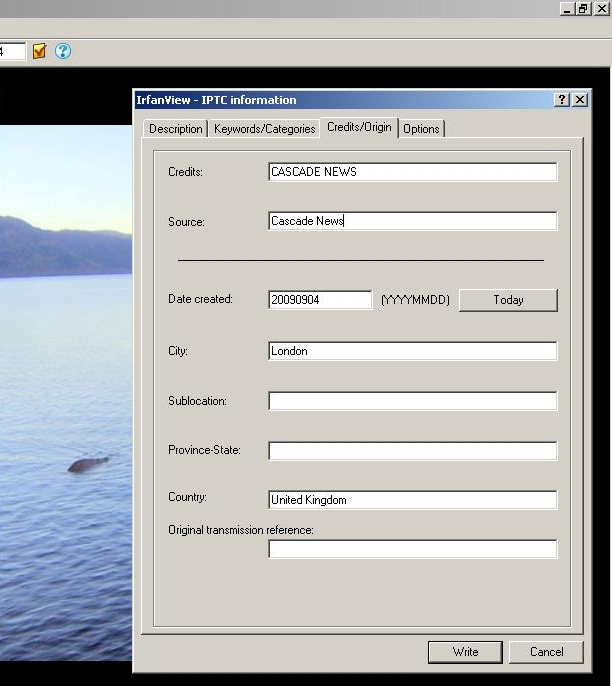
On 14th August 2012 I had the opportunity today to take the Castle Cruises tour boat to my calculated location for the Edwards photography. I had no monsters to hand but I did have a 25 cm long Buxton Spring Water 1 litre bottle, which I threw into the water and photographed. The results are shown below.
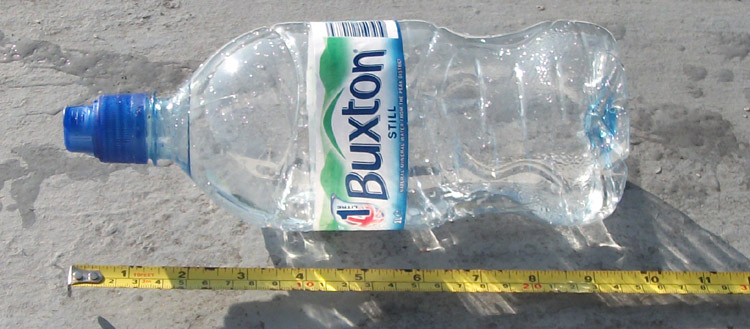
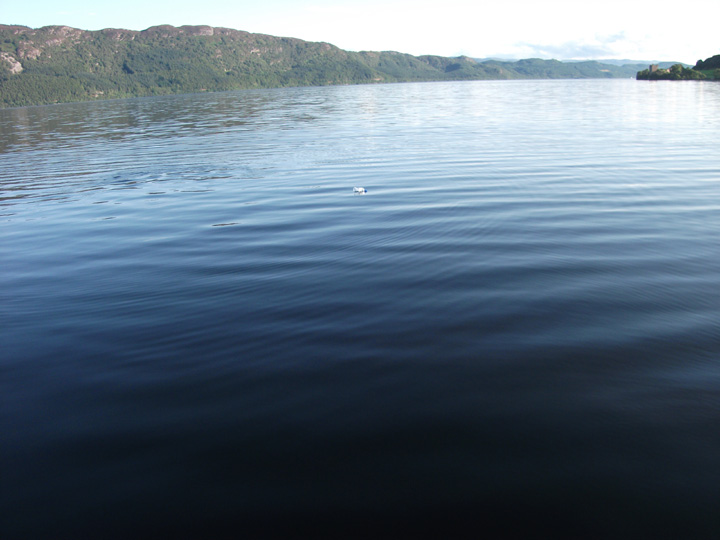
and when superimposed on the George Edwards photo, taken from "near Lochend" (6 miles away), rotated and resized ...
(Right-click and select "play"
The similarities between the "November 2011" photograph and my own photograph of a bottle show clearly that the object in the former was only a few metres away from the camera, and not "half a mile away".
Steve Feltham has pointed out the close similarity to a plastic "monster hump" used in the making of a tv programme "Loch Ness Monster: The Ultimate Experiment". In photographs I have seen the hump appears to be 1.5 to 2 metres long, substantially longer than my calculations suggested and this could be accounted for if a photo of the "monster hump" had been digitally superimposed on the background photograph at a reduced scale. The original image file is unfortunately not available for inspection.
On 21st August 2012 I visited Steve Feltham at Dores and was shown the glass-fibre hump. My measurements showed it to be about 1.9 metres long and 0.3 metres high, and clearly the same object as portrayed in George Edwards postcards and press releases. The question I cannot answer at present is how such a large object has been shrunk down to the 0.6 metre (approx) object in the image distributed by Cascade News. Either my calculations and bottle simulation (above) are wrong by a factor of 3, or the image has been digitally manipulated and the whole episode is a hoax.
More IPTC data from an online version of the "November 2011" photo is shown below. This data is generated by the photographer or others after the photograph was taken.
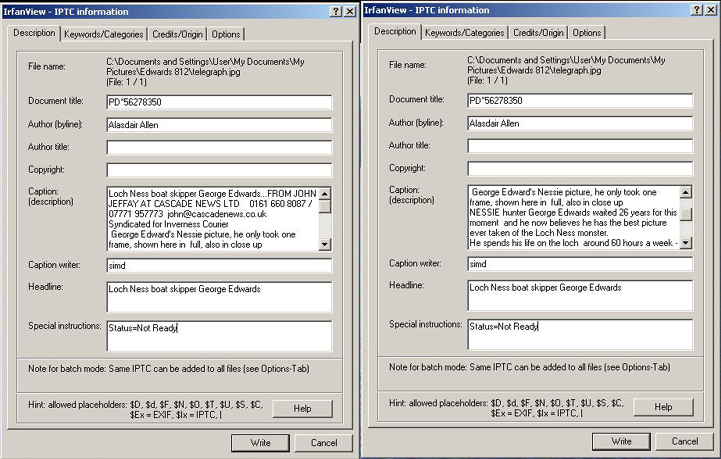
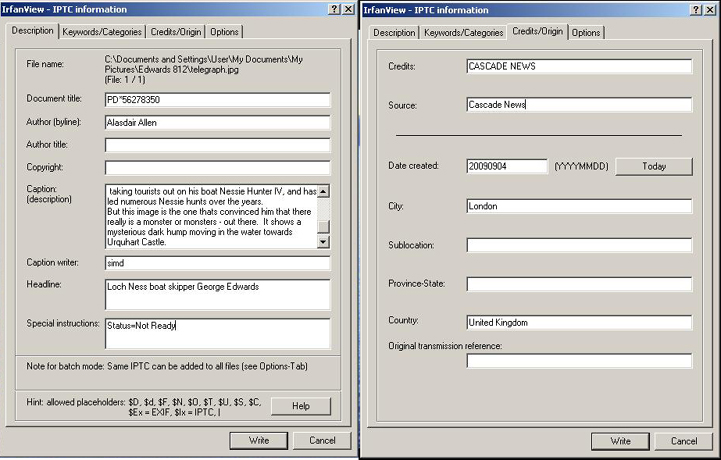
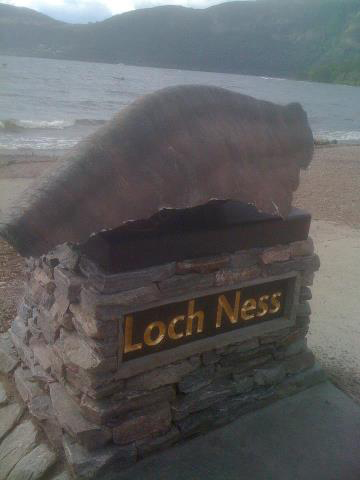
The glass-fibre hump at Dores Beach. Photo - Steve Feltham. Who shrunk the monster?
On 22nd August 2012 Mr Edwards told STV News that he denied knowing anything about a fake hump.
On 23rd August 2012 I reviewed my recording of "The Truth Behind the Loch Ness Monster", filmed at Loch Ness in early 2011. At 5 mins 48 sec into the film, just after divers have entered the water, there is a shot of two men on George Edwards boat with the glass fibre hump on the foredeck. I have enlarged the fore-deck object as an inset in the frame below from the tv show.
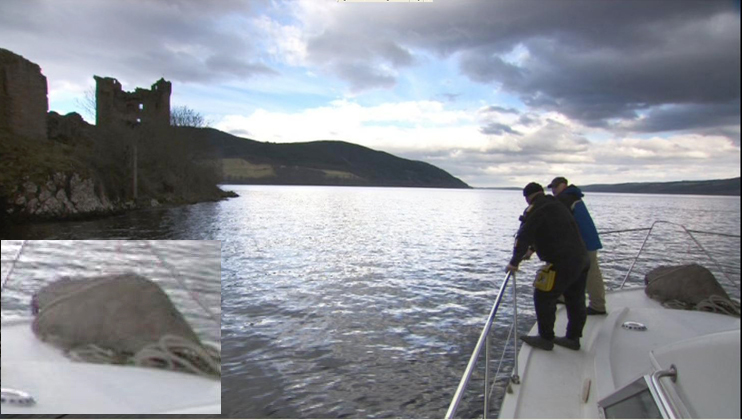
A frame from "The Truth Behind the Loch Ness Monster" by ZigZag Productions for which I claim Fair Use.
Update 24th August 2012.
Since the page was originally composed Steve Feltham has uncovered both a film-makers "prop" that fits the object in the "November 2011 Photograph", and pointed us to various sequences in "The Truth Behind the Loch Ness Monster" by Zig Zag Productions which show the glass-fibre hump on the deck of George Edwards boat during the filming in early 2011.
My doubts about the boat part included in the photograph were based upon the almost vertical object in the bottom left corner of the photograph which I could not reconcile with any part of the deck fittings on Nessie Hunter IV. I have now found one on the fly bridge - arrowed in red below. In the "TTBTLNM" documentary the boat still had dinghy davit fittings in place at the stern which also have vertical elements.
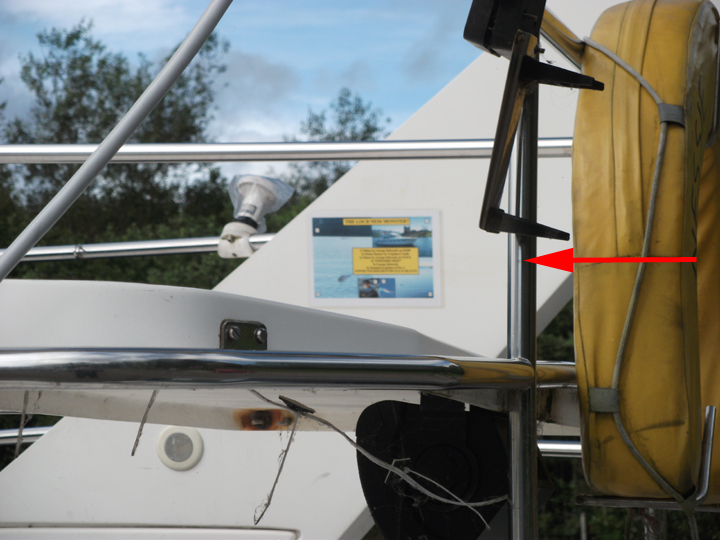
The finding of this structural feature - one of four similar vertical handrail supports on the fly bridge allows a recalculation of the camera height to about 4 metres, places the camera about 85 metres closer to Urquhart Castle at 900m range, and doubles the range to the hump to 17.5 metres. It now would appear to be about 2 times bigger than my original calculation, and so 1.2 metres long on the water. Of course some of it's actual length of 1.9 metres would be submerged so there is no significant conflict in the data.
The weather conditions in the "November 2011" monster photo match those in the documentary.
In all hoaxes the simplest explanation is often the best, and it is hard not to conclude that George Edwards simply took a digital snap from the fly bridge during a filming cruise and decided to publish it as a postcard.
Summary
1/ Edwards' Deep - There is no evidence today that Edwards' Deep exists, and George Edwards doesn't demonstrate its location to passengers despite passing close to its claimed location on every cruise.
2/ The 1986 Photograph - His earlier photograph dated 1986 was admitted by himself at the time to be a staged photo.
3/ November 2011 Photograph - There is evidence in the photograph that it was not taken from his current boat purchased in early 2011.(Withdrawn 24th August 2012 - see Update above)
4/ November 2011 Photograph - There is evidence that it was taken from his older boat sold before the 2011 season. (Withdrawn 24th August 2012 - see update above)
5/ November 2011 Photograph - The known weather records don't match the conditions shown in the "November 2011" photograph on either of the dates he has given.
6/ November 2011 Photograph - The embedded data in one of the "November 2011" photographs names the photo agency and bears a date of "20090904"
7/ November 2011 Photograph - George Edwards claims the photo was taken "near Lochend" when it was clearly taken in Urquhart Bay, some six miles away.
8/ June 2012 Audio commentary In his audio commentary of June 2012 he states he last saw one of the creatures on 13th May 2003.
Intellectual Property Rights Assertion and Copyright Dick Raynor 2012.
This work was created in August 2012 by Dick Raynor.
The page was modified on 18/08/2012 with revised camera height data and minor changes to text.
Updated 21/08/2012 with references to new material published by Steve Feltham
![]()
"An examination of claims and pictures taken by George Edwards" by
Dick Raynor is licensed under a Creative Commons Attribution-NonCommercial-NoDerivs 3.0 Unported License.
Permissions beyond the scope of this license may be available at
permissions.html